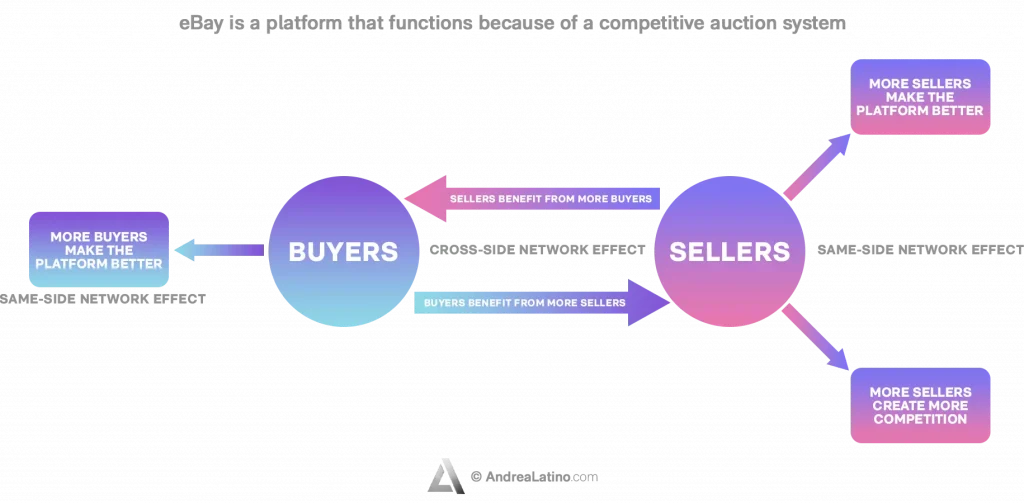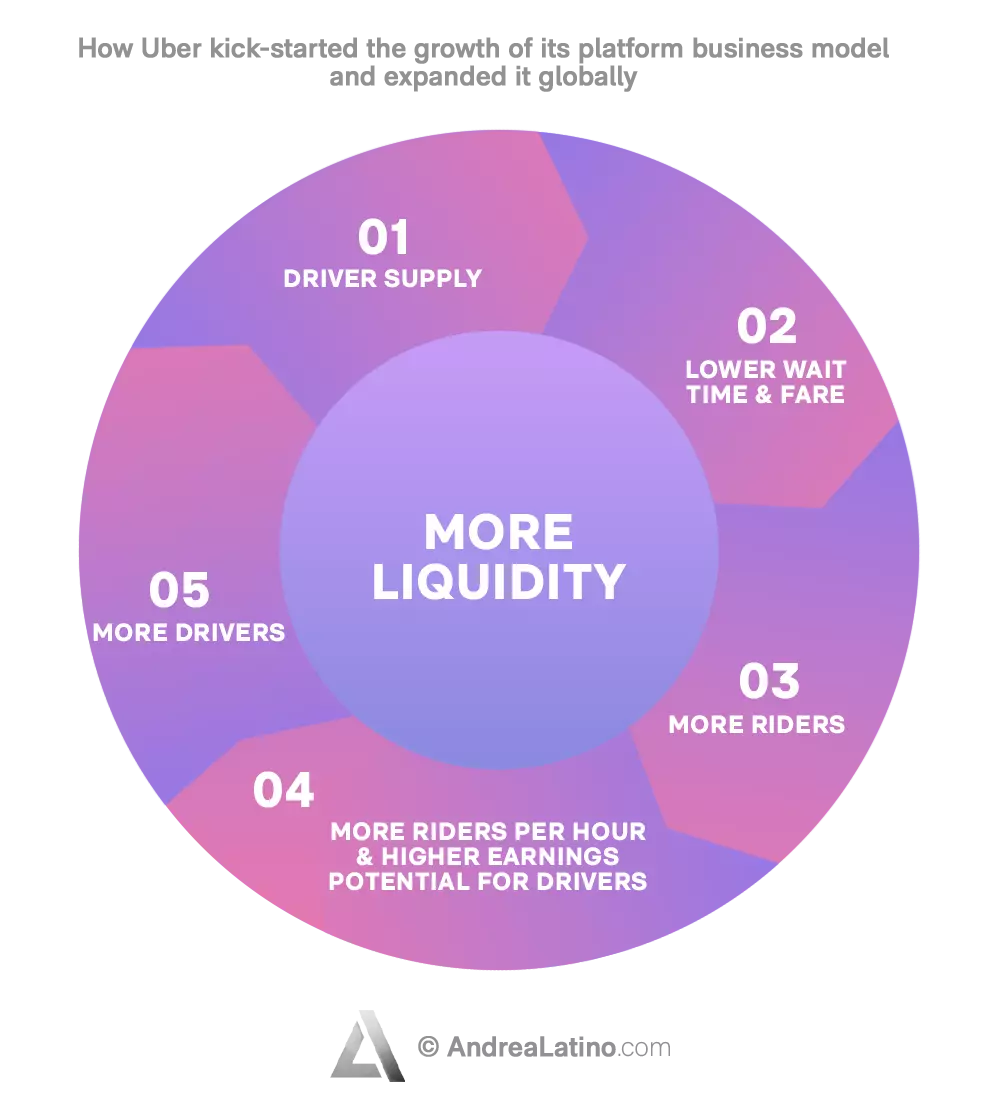Innovation Alphabet
Network Effect
in a nutshell
The bigger, the better. The network effect (also called the snowball effect) is an economic phenomenon whereby growth in the number of users increases the value of a good or service. Each user, in turn, incentivizes other people to join the network, adding even more value, and so on. The consequences are tangible: the effect determines power relations and distributes the power of the new economy, creating web monopolies.


Application Fields
• Social media: Social networks, as the name suggests, are an obvious example of network effect. As users register with the platforms, companies sniff the opportunity and try to advertise themselves by registering as well. The increase in advertisers brings in more revenue for social media. The latter, as a result, evolve and are able to offer even more services to their members.
• Finance: Stock exchanges and derivatives are characterized by the snowball effect. As trading volumes increase, liquidity also rises, while transaction costs fall. This is a phenomenon that attracts a large number of buyers and sellers.
• Websites: Just think of online marketplaces, such as eBay, a platform that functions because of a competitive auction system. The more eBay users, the more competitive the auctions become, and consequently the number of bids to win the desired item soars. This is a situation that makes trading on the site profitable and, as a result, attracts sellers in large numbers. This leads to lower prices due to an increase in supply, which simultaneously diversifies.

Do you have a Marketing & Sales challenge to tackle? Let’s face it. Together.
C-levels from these companies (AND MORE) relied on my expertise to overcome thEIR CHALLENGES IN THIS AREA. And You can, too.
Can I help you?Industries
• Network Effect in ridesharing services
Uber gained popularity and evolved through the support of users who signed up and, from time to time, amplified the platform’s outreach. The brand gained market value in relation to the amount of drivers and passengers who registered.

• Network Effect in cryptocurrencies
The unique and advantageous properties of bitcoin make it an attractive asset for investors. The more users join its network, the more it gains value and security. By incorporating the study of the mechanisms that produce snowball effects into the design process of new digital currencies and blockchain networks, the scale-up of cryptocurrencies could be accelerating.
Business Functions
• Network Effect in support of Amazon
The world’s largest Internet company has acquired Whole Foods Market, a company that does not fall into the category of businesses usually purchased by Jeff Bezos. In fact, Amazon’s founder has always focused on competing businesses (Zappos, Woot, and Quidsi, to name a few) or start-ups (Alexa, or Elemental Technologies), to go and complement and extend his offerings. Here, the Whole Foods operation falls within the logic of the network effect. Now, Amazon can also add users included in the food and fruit and vegetable sector to its network of contacts.
• Network Effect in support of Google and YouTube
Google Video (yes, it existed) could never compete with YouTube. So, Google decided to buy the world’s most popular video sharing platform, turning it into a great channel for advertising through the development of a unique Video Ad system.
• Network Effect in support of Facebook
The social network created by Mark Zuckerberg was launched with a clustered approach: initially, the focus was entirely on product development. When more than 80 percent of Harvard students were enrolled in Facebook, the level of engagement was considered high enough to expand. So much so that initially the platform was criticized because it seemed that it could not grow fast enough. In reality, its expansion was strategic.
Stay in wonderland
Let me show you how deep the rabbit hole goes.
Check out more of the Innovation Alphabet:

3D Printing
3D Printing
“3D printing” is a process carried out by an electronic device which, instead of resorting to the canonical ink, it molds almost any kind of material: from concrete to living tissue, most usually plastic, but also metal. And the operating principle is similar to that of a traditional printer. The creation of three-dimensional models can lead to the redesign of a company’s production capabilities.
Dive In
5G
5G
5G is the new frontier of cellular telephony. It was designed to improve (or completely replace) previous generations of mobile networks. The 5th generation features lower latency, ensuring flawless performance of business applications and many other digital experiences – thus enabling the new cultural generations to furiously play Fortnite away from home.
Dive In
Advanced Analytics
Advanced Analytics
The term “Advanced Analytics” refers to the ability to autonomously or semi-autonomously analyze data and content to identify correlations, develop analyses, predictions, and recommendations. It is not just a matter of collecting information and then organizing it into watertight compartments: the ultimate goal is to identify a dialogue pattern from a data-driven perspective.
Dive In
Agile
Agile
Agile is an approach to software development designed to respond to change. Teams quickly analyze the context in which they operate, identify uncertainties faced, and figure out how to adapt to always move forward. Interaction between individuals comes before processes and tools; collaboration with the customer is more important than negotiating contracts.
Dive In
Ansoff Matrix
Ansoff Matrix
The Ansoff Matrix is a marketing planning model that arises from the intersection of new and existing products and markets. It derives four possible strategies for expanding the company’s market, which are built around four variables with a changeable factor of risks and possibilities: existing product, new product, existing market, new market.
Dive In
Artificial Intelligence
Artificial Intelligence
Artificial Intelligence is not strictly defined. Basically, it is a computer system able to make decisions in an independent and flexible way. A good AI application can perform everyday tasks better than an average person (e.g., identifying other people from their photos on social media or beating the best chess player). Nothing to fear, then. Unless you are a chess champion.
Dive In
Artificial Scarcity
Artificial Scarcity
We often tend to desire what we cannot have. Or what we are in danger of losing: Artificial Scarcity is a strategy that flaunts a limited number of items that do not correspond to actual availability. The goal is to stimulate the perception in consumers that the stock of items is about to run out and thus create a need based on the “fear of being cut off” or the intention to buy the item in order to resell it at a higher price.
Dive In
Attack Surface
Attack Surface
The term attack surface refers to the part of a system that may be subject to attack or breach by hackers. The smaller that surface is, the easier it will be to protect it. Indeed, the Internet is an ocean of deep, dark waters: those who navigate it must be aware that they are exposing themselves to a flood of digital risks. Yet, ironically, we do not need a big boat to shelter us.
Dive In
Augmented Reality
Augmented Reality
Augmented Reality is an ever-evolving technology that overlays multimedia information on top of our common sensory horizon to gain a deeper understanding of our surroundings. No, it doesn’t allow you to step out of the Matrix dream simulation, nor can it be accessed by swallowing a red pill. But neither is it the disturbing experience of the Playtest episode of Black Mirror.
Dive In
Balanced Scorecard
Balanced Scorecard
In business, as in life, you need balance. The Balanced Scorecard is a holistic tool for strategic management. It offers, in fact, the possibility of assessing corporate performance in its wholeness. An overview that embraces four perspectives: the business/financial side, customers and stakeholders, internal processes, and learning and growth.
Dive In